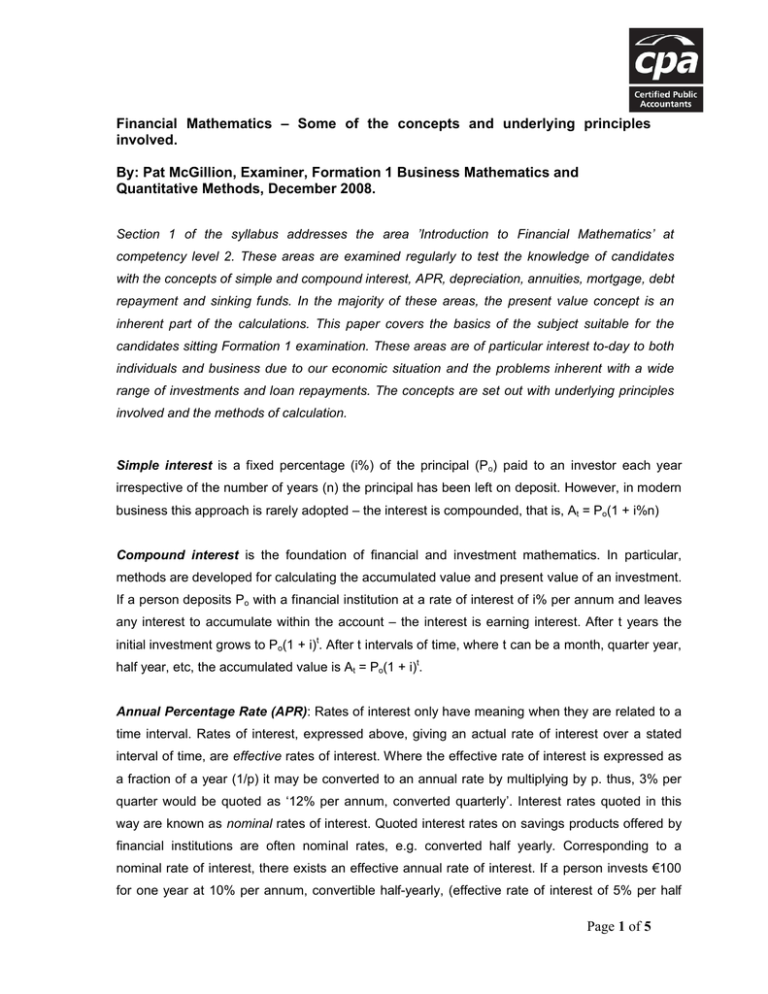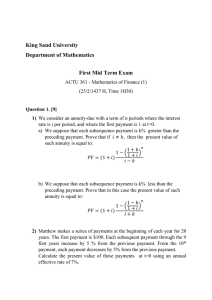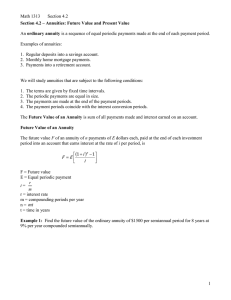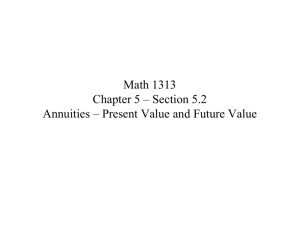Financial Mathematics – Some of the ... involved. By: Pat McGillion, Examiner, Formation 1 Business Mathematics and
advertisement

Financial Mathematics – Some of the concepts and underlying principles
involved.
By: Pat McGillion, Examiner, Formation 1 Business Mathematics and
Quantitative Methods, December 2008.
Section 1 of the syllabus addresses the area ’Introduction to Financial Mathematics’ at
competency level 2. These areas are examined regularly to test the knowledge of candidates
with the concepts of simple and compound interest, APR, depreciation, annuities, mortgage, debt
repayment and sinking funds. In the majority of these areas, the present value concept is an
inherent part of the calculations. This paper covers the basics of the subject suitable for the
candidates sitting Formation 1 examination. These areas are of particular interest to-day to both
individuals and business due to our economic situation and the problems inherent with a wide
range of investments and loan repayments. The concepts are set out with underlying principles
involved and the methods of calculation.
Simple interest is a fixed percentage (i%) of the principal (Po) paid to an investor each year
irrespective of the number of years (n) the principal has been left on deposit. However, in modern
business this approach is rarely adopted – the interest is compounded, that is, At = Po(1 + i%n)
Compound interest is the foundation of financial and investment mathematics. In particular,
methods are developed for calculating the accumulated value and present value of an investment.
If a person deposits Po with a financial institution at a rate of interest of i% per annum and leaves
any interest to accumulate within the account – the interest is earning interest. After t years the
initial investment grows to Po(1 + i)t. After t intervals of time, where t can be a month, quarter year,
half year, etc, the accumulated value is At = Po(1 + i)t.
Annual Percentage Rate (APR): Rates of interest only have meaning when they are related to a
time interval. Rates of interest, expressed above, giving an actual rate of interest over a stated
interval of time, are effective rates of interest. Where the effective rate of interest is expressed as
a fraction of a year (1/p) it may be converted to an annual rate by multiplying by p. thus, 3% per
quarter would be quoted as ‘12% per annum, converted quarterly’. Interest rates quoted in this
way are known as nominal rates of interest. Quoted interest rates on savings products offered by
financial institutions are often nominal rates, e.g. converted half yearly. Corresponding to a
nominal rate of interest, there exists an effective annual rate of interest. If a person invests €100
for one year at 10% per annum, convertible half-yearly, (effective rate of interest of 5% per half
Page 1 of 5
year) – not the same as an effective rate of interest of 10% pa - the amount at the end of the year
is €100(I + 0.10/2)2 = 1.1025. If the annual rate of interest is i% pa the amount at the end of the
year is €100(I + i). Therefore, 1 + i = 1.1025, giving i = 10.25%. A rate of interest expressed as
10% pa, convertible half yearly, is the same as an effective rate of interest of 10.25% or quoted as
the APR (annual percentage rate). This process may be generalized as follows:
Nominal rate compounded n times per year: At = Po(1 + i/n)nt
APR rate compounded annually: At = Po(1 + APR)t
Since the yield is the same, Po(1 + i/n)nt = Po(1 + APR)t giving an APR of (1 + i/n)n – 1.
Depreciation: Depreciation is of two principal types – straight line and reducing balance. Straightline depreciation is the converse of simple interest with equal amounts being subtracted from the
original asset value each year. If the original value of an asset is Vo, and after t years its value is
Vt, the amount of depreciation each year is (Vo – Vt)/t.
Reducing-balance depreciation is the converse of compound interest. Larger amounts are
deducted from the original asset value each year. If the asset devalues at a rate of i% each year,
over t years the depreciated value of the asset, after t years, is
Vt = Vo(1 – i)t; therefore, the amount of depreciation is Vo – Vt.
Present value: To consider many of the financial areas, it is necessary to appreciate the concept
of the net present value of an investment. The present value of a sum of money (Vo) to be paid in t
years is derived by the equation Vo = Vt/(I + i)t. The net present value is the present value of
several future sums discounted back to the present.
Annuities: In today’s economic climate the areas of major interest to both individual and
business, due to the collapse in investment values and interest rates, are the concepts of
annuities, mortgages and debt repayments.
An annuity is a series of equal payments, investments or withdrawals made at regular time periods
– generally a payment made towards insurance policies, personal loans, hire-purchase payments,
investment and pension funds, weekly, monthly or annually. This is one of the most popular
retirement investment options. They can be used as a general investment or within a qualified
retirement plan. There are various different types of annuity but if the investment is made at the
time of compounding it is an ordinary annuity. Annuities may be paid at the end or the beginning of
payment intervals. The term of an annuity may begin and end on fixed dates, may be a contingent
or perpetual annuity that carries on indefinitely.
Page 2 of 5
Annuities are of major interest to impending retirees due the collapse in investment returns. Since
annuities are the main forms of pension payment this means that an individual invests part of
his/her income with an approved financial services provider over the period of his/her working life.
This investment accumulates in value and, on retirement, the individual is obliged to use the fund
to purchase an annuity – a monthly series of payments in arrears which provides an income for
the individual over his/her expected life span. These are two stage annuities where the first stage
requires regular payments into the pension fund until retirement (these annuities are due – paid in
advance of the event, the investment has not started until the first payment has been made) and
the second stage is the receipt of regular income until death.
The means to derive the value of this investment over a period of t years, where Ao is the amount
invested at the end of each year, is the series Ao + Ao(I + i) + Ao(I + i)2 + Ao(I + i)3 + …………….. +
Ao(I + i)t-1. This is a geometric series where a = Ao, r = (I + i) and the sum, that is, the total amount
of the annuity, becomes [Ao(I + i)t – 1]/i – the total value of the annuity at the end of t years. This
basically is the compound interest for fixed deposits at regular intervals of time.
However, if a series of equal payments or withdrawals will be made in the future, it is necessary to
get the present value of the annuity. The key question being asked is: how much should be
invested now (Vo) for t years at a given rate of interest, i% per annum, to cater for a series of equal
annual payments, Ao. The value of a series of regular payments at the end of t years is Vt = [Ao(I +
i)t – 1]/I; if the amount invested [Vo(1 + i)t] is adequate to provide for this series of payments, then
Vo(1 + i)t = [Ao(I + i)t – 1]/i. Therefore, the value of the investment at the end of t years is equal to
the investments compounded annually.
This simplifies to Vo = Ao[1 - (I + i)-t]/i where [1 - (I + i)-t]/i is called the ‘annuity factor’.
In some cases investors may decide to invest in assets or additional pension products (such as a
PRSA) to avail of maximum taxation concessions. This may be done by a once-off annual
payment. The value of this section of the investment is Vt = Vo(1 + i)t where Vo is the initial
payment. Therefore the value of the total investment, Vt, at the end of t years, is the initial
investment, Vo, plus the annual investments, Ao, compounded
Vt = Po(1 + i)t + [Ao(I + i)t – 1]/i.
This is also the basis for the calculation of a range of annuities, mortgages, and debt repayments.
Page 3 of 5
Debt and mortgage repayments: Many companies and individuals borrow monies and make
arrangements that the loan and interest is repaid in equal amounts over equal periods of time. A
loan of this type is said to be amortised. For such a repayment the values of the loan and interest
are normally known but the regular amount to be repaid must be calculated. To calculate the value
of each repayment the above concept is used: Vt = Po(1 + i)t + [Ao(I + i)t – 1]/i. At the end of the
period, the total loan, Vt, is repaid (equals zero). The debt or loan/mortgage Po (L) at the end of t
years, at a rate of interest i per annum, [Po(1 + i)t], is a negative investment and must be repaid.
Therefore 0 = -L(1 + i)t + [Ao(I + i)t – 1]/i. By simplifying this equation the regular annual payment
(Ao) is L[i/{1 – (1 + i)-t}. This value, the ‘capital recovery’ factor is the inverse of the ‘annuity factor’.
Sinking Funds: A sinking fund is created by setting aside a fixed sum of money each year with
the objective of repaying debts/loans or making provision for the replacement of assets or
equipment. This is similar to establishing an annuity to make provision for the loan repayment
where a deposit is made at the beginning of each year. If a fixed sum is set aside each year, Ao,
the value of the fund will grow annually. At the end of year 1, the value of the fund is Ao(I + i) + Ao,
etc. At the end of t years, the value of the fund is
Ao(I + i)t + Ao(I + i)t-1 + (I + i)t-2 + ---------- Ao(I + i). By using a geometric series, as previously, the
value of the fund is derived as Ao(1 + i){[(1 + i)t – 1]/i}.
These investments/repayments can be set out on a schedule particularly if the information is
required on an annual basis.
In all of the above, if the investment, mortgage or debt is compounded monthly, i and t become
i/12 and 12t. A similar principle applies for other compounding periods.
Since the level of calculation of these investments over long periods is complex the financial
provider supporting such investments provides prepared tables of the calculations.
Summary:
Simple interest:
Pt = Po(1 + it)
Compound interest:
Pt = Po(1 + i)t
Annual percentage rate:
APR of (1 + i/n)n – 1; compounded n times pa
Page 4 of 5
Annuities, debt repayment, sinking funds:
Value of initial investment Po and investments Ao at regular time periods, t
Vt = Po(1 + i)t + [Ao(I + i)t – 1]/i
Value of annuity:
Vt = [Ao(I + i)t – 1]/i
Present value of annuity:
Vo = Ao[1 - (I + i)-t]/i
Repayment on loan, L:
Ao = L[i/{1 – (1 + i)-t}
Value of sinking fund payments:
Vt = Ao(1 + i){[(1 + i)t – 1]/i}.
Supporting References:
Bradley T, (2008), Essential Mathematics for Economics and Business, Wiley & Sons
Adams A, Booth P.et al, (2007), Investment Mathematics, Wiley & Sons
Lucey T, (2002), Quantitative Techniques, Continuum Publications
Page 5 of 5








